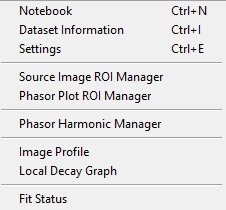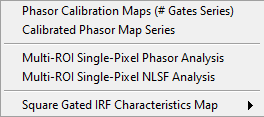AlliGator Menus
Some of AlliGator’s functions can be performed via the top menu bar (and associated shortcuts). The menus are File, Windows, Analysis, Calibration, Settings and Help
File Menu

LoadFLI DatasetGate Image Folder: is used with data consisting of series of imagesHDF5 File: allows loading datasets saved in the HDF5 open source file format used by AlliGator.sdt File: loads Becker & Hickl histogrammed FLIM files.ptu File: loads PicoQuant TCSPC FLIM files.bin File: loads PicoQuant histogrammed FLIM filesSwissSPAD 1 .dat File: loads a file generated by the first generation SwissSPAD cameraReload Dataset: forces reloading the current dataset (used to apply new settings)
FLI Dataset SeriesGate Image Folder Series: is used with folders of folders of data consisting of series of imagesHDF5 File Series: allows loading a folder of datasets saved in the HDF5 open source file format used by AlliGator.sdt File Series: loads a folder of Becker & Hickl histogrammed FLIM files.ptu File Series: loads a folder of PicoQuant FLI files.bin File Series: loads a folder of PicoQuant histogrammed FLIM files
White Light Image: opens a single image of the sample (or any other image) which will not be used for data analysisMask Image: opens a mask image used to define regions of interest for data analysisIntensity Corrections File: opens a file containing corrections to apply to intensity values in the series
SaveDatasetSave as TIFF Gate Image Folder: saves gate images loaded in AlliGator as TIFF filesSave as HDF5 FLI Dataset: saves any file loaded in AlliGator in the open source file HDF5 format used by AlliGator
Mask Image: saves the current Mask Image to a TIFF file
Batch Conversion: opens a window allowing the selection of multiple FLI Datasets and exporting them to HDF5 FLI Dataset files or TIFF Image Series.Quit: quits AlliGator with confirmation, offering to save the Notebook content (Ctrl+Q)
Windows Menu

Notebook: opens the Notebook window (Ctrl+N).Dataset Information: opens the Dataset Information window (Ctrl+I).Settings: opens the Settings window (Ctrl+E).Source Image ROI Manager: opens the Image Source ROI Manager window (Ctrl+Shift+R).Phasor Plot ROI Manager: opens the Phasor Plot ROI Manager window.Phasor Harmonic Manager: opens the Phasor Harmonic Manager window.Image Profile: opens the Image Profile window.Local Decay Graph: opens the Local Decay Graph window.Fit Status: opens the Fit Status monitoring window.
Scripts Menu

Phasor Calibration Maps (# Gates Series): computes phasor calibrations maps for different step parametersCalibrated Phasor Map Series: computes calibrated phasors plots for a series of dataset/gate step/calibration mapMulti-ROI Single-Pixel Phasor Analysis: computes calibrated single-pixel phasors for the current ROIsMulti-ROI Single-Pixel NLSF Analysis: performs single-pixel NLSF analysis for the current ROIsSquare Gated IRF Characteristics Map: fits ROI decays with one of the following gate models:Square PulseLogistic Square PulseTilted Logistic Square Pulse
Analysis Menu

Fluorescence Decay Statistics: analyzes all single pixel decays within the data set and builds an histogram of the minimum and maximum intensity in each decay. This analysis is discussed in more details in the Fluorescence Decay Statistics page of the manual (Ctrl+D).Define Intensity Corrections: opens the Define & Save Intensity Corrections File window discussed in the Intensity Corrections Definition manual page.Global Fit of Selected Decays: performs a global fit of decays selected in theDecay Graph(Fluorescence Decay panel). Details can be found in the ref:Fluorescence Decay NLSF <fluorescence-decay-nlsf> page of the manual.Current ROI Analysis: performs an analysis of the pixels located within the selected ROI or, if theUse ROI as Search Areabutton is pressed, in the optimal ROI within that region (Ctrl+A).Multiple ROIs AnalysisAll ROIs IRF ExtractionInteractive (Slow)Non-interactive (Fast)All ROIs Decay FitInteractive (Slow)Non-Interactive (Fast, Common IRF)Non-Interactive (Fast, Individual IRF)
All ROIs (Phasor) AnalysisInteractive (Slow): performs the same analysis asCurrent ROI Analysison all ROIs currently defined, in the order they appear in the ROI Manager. In particular, it will plot the corresponding decay, add a data point to a new phasor plot in the Phasor Graph and display the current location of the ROI. This can take quite a long time in the case of a very long list of ROIs or for large datasets.Non-interactive (Fast): performs the same analysis asCurrent ROI Analysison all ROIs currently defined, in the order they appear in the ROI Manager. No decay is plotted, the phasor plot resulting from the analysis in only displayed at the end, and no ROI is displayed on the * Source Image* during the analysis. This mode is recommended, as it is much faster than the previous one (> x10).
Series AnalysisSeries Phasor: performs phasor analysis of the loaded dataset series.Series Fit: performs a decay fitting analysis of the loaded dataset series.Sum All Datasets in Series: loads each dataset in a selected series and builds a dataset in which each gate image is the sum of the corresponding gate images of all datasets in the series. If the Average Dataset Sum checkbox in the Settings:Source Image panel is checked, the summed dataset is divided by the number of datasets, obtaining an average dataset.
Warning: This dataset is temporary (as indicated by the asterisk which appears
after its name in the AlliGator window title). It can be saved immediately
using the File:Save HDF5 Dataset (Ctrl+S) menu item. Any action
that will update the dataset loaded in memory (such as for instance using the
Time Point Slide next to the Source Image), will hide this dataset.
However, it can be displayed again by selecting the Analysis:Series
Analysis:Show Dataset Series Sum menu item.
Playback: will load and display the datasets in a time series, without processing the data (contrary to theTime-Series Analysismenu item). It can be stopped by selecting thePlaybackmenu item again or pressing the Abort button. (Ctrl+P).Loop: performs the same function as playback, but resumes playback from the start when the end of the series is reached. It can be stopped by selecting theLoopmenu item or pressing the Abort button. (Ctrl+Shift+P).
Calibration Menu

The menu is comprised of three sub-menus:
Single Phasor CalibrationUse Single Phasor Calibration: performs the same action as selectingSingle Phasorin the Calibration Type pull-down list in the Phasor Graph panel. Both are linked (the pull-down list is updated when the menu item is selected and vice versa).Save Phasor Calibration: saves the currently used single calibration phasor to a XML file.Load Phasor Calibration: loads a previously saved calibration phasor,Clear Phasor Calibration: removes the stored calibration from memory.
Phasor Calibration SeriesUse Phasor Calibration Series: performs the same action as selectingPhasor Seriesin the Calibration Type pull-down list in the Phasor Graph panel. Both are linked (the pull-down list is updated when the menu item is selected and vice versa).Save Phasor Calibration Series: saves the currently used calibration phasor curve to a XML file.Load Phasor Calibration Series: loads a previously saved calibration phasor curve,Clear Phasor Calibration Series: removes the stored calibration curve from memory.
Phasor Calibration MapUse Phasor Calibration Map: performs the same action as selectingPhasor Mapin the Calibration Type pull-down list in the Phasor Graph panel. Both are linked (the pull-down list is updated when the menu item is selected and vice versa).Save Phasor Calibration Map: saves the currently used calibration phasor map to a XML file.Load Phasor Calibration Map: loads a previously saved calibration phasor map,Clear Phasor Calibration Map: removes the stored calibration map from memory.
Settings Menu
Load Settings:Save Settings:Export Settings to NotebookAll Settings: writes all settings currently used in AlliGator in the Notebook for future reference. Some of these settings are added to the Notebook during the course of data analysis. This function conveniently regroups all settings in one single location in the Notebook. The following items limit the content of the Settings window that is exported to the Notebook:Source ImageData InformationFluorescence DecayAll SettingsDecay Pre-ProcessingAdvanced AnalysisFit OptionsFit ParametersStyles
Settings: opens the Settings window
Help Menu

Show Context Help: shows a floating window providing basic information on the object pointed at with the mouse pointer (Ctrl+H).Online Manual: opens a page in the default browser redirecting to this website.Check for Update: visits the Installation webpage to check the latest released version. If a newer version is found, the software offers to download and install it. The new version will be used on the next time AlliGator is started.About AlliGator: opens a dialog window providing basic information on AlliGator.